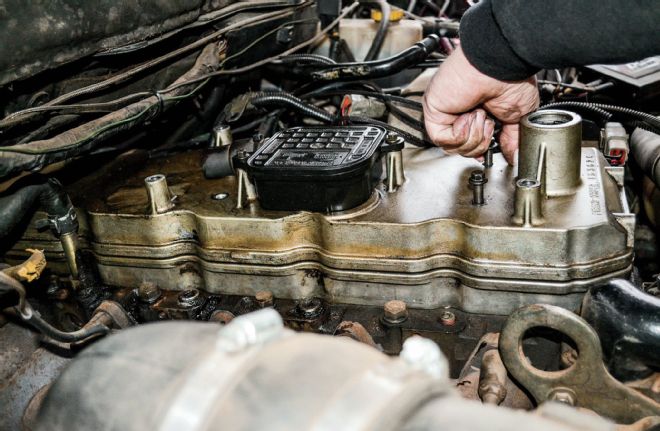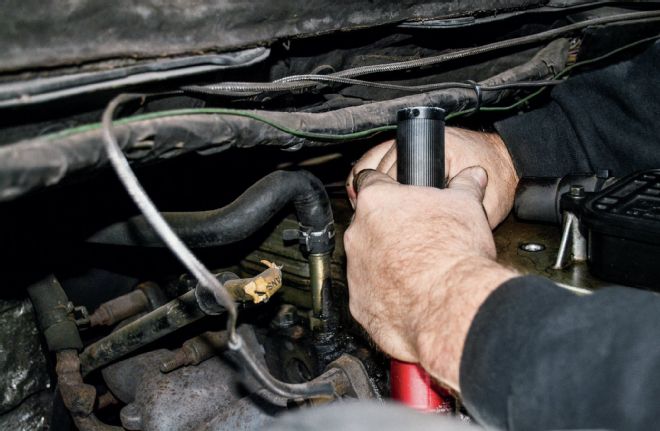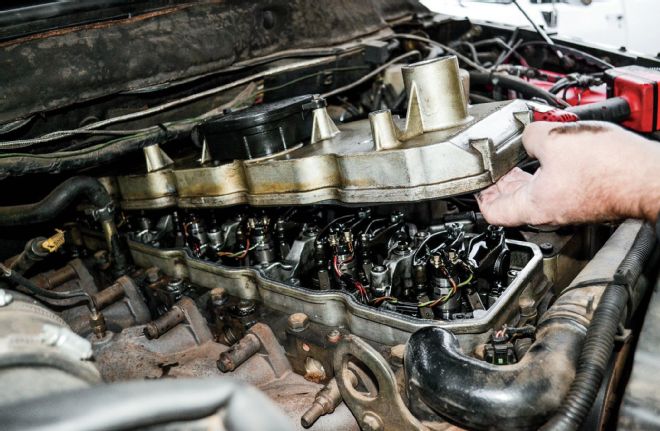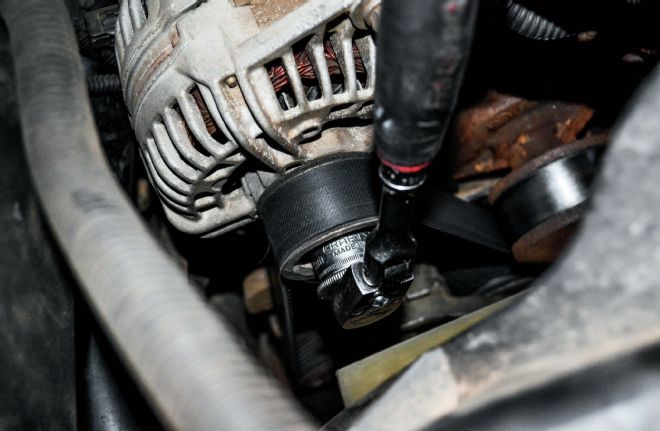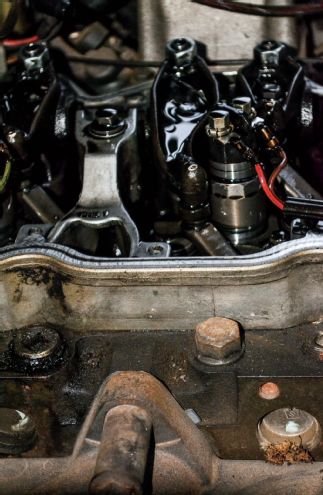While many folks view diesel engines as indestructible, they do still need maintenance. Oil changes, fuel filter replacement, and cleaning or changing the air filter are all important items when it comes to keeping your diesel reliable. In addition to external filters, there’s also maintenance inside your diesel engine that should be performed.
Valve lash, for example, is something that should be checked at least every 135,000 miles on a Cummins diesel engine, although many people adjust it even sooner. We’ve heard of valves being out of adjustment at 90,000 or even 70,000 miles, so checking them is a good idea. Valves that aren’t within specifications can affect fuel economy, lead to a ticking noise in the engine, and even reduce power. If the valve lash is too loose, the valve won’t be taking advantage of the full lift of the camshaft, and therefore the engine will be hampered in its airflow potential.
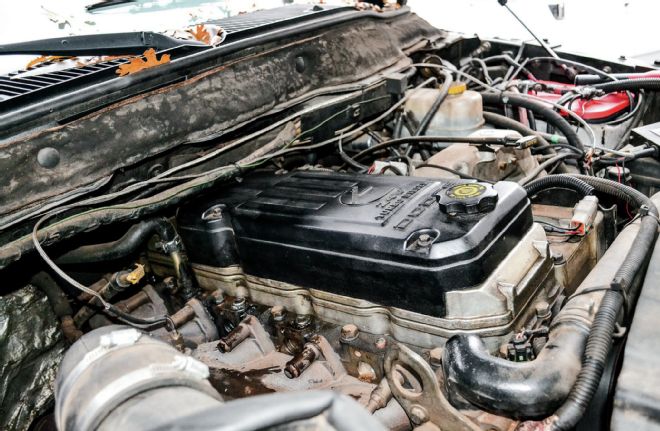
| As you can see by the dirt and oil leaks, we figured it was probably a good time to check the valve lash on this 200,000-mile Cummins, as we’re sure it had been a while.
At a shop, a valve adjustment can cost you hundreds of dollars, but it’s actually something quite simple you can do in your own driveway. In addition to a 22 or 24mm socket (which most people don’t have lying around), the procedure can be done with basic handtools and takes about an hour or so, depending on your work pace and how many valves need adjustment. There are a few different methods of adjusting the valves for the do-it-yourselfer, but the sequence we’re presenting is called the overlap method and involves looking for valve overlap on the #1 cylinder and the #6 cylinder in the engine.
On an inline engine such as the Cummins, there are companion cylinders that are at top dead center (TDC) at the same exact time. The only difference is that one cylinder will be on either its compression or power stroke, while the other companion cylinder will be on its intake or exhaust stroke. This sequence achieves the smoothest running engine possible, as having companion cylinders that fired at the same time would lead to a very rough running engine.
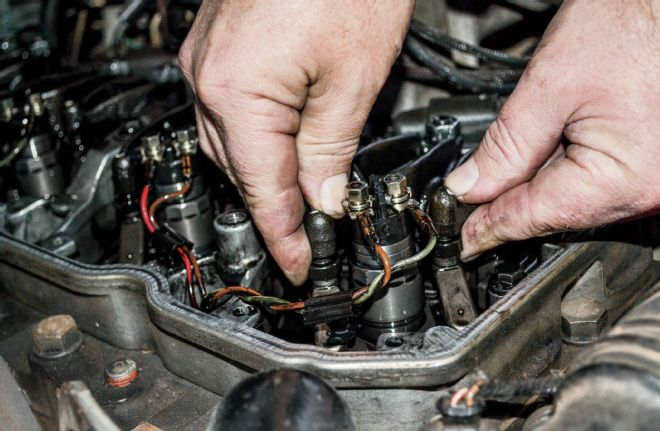
| First, we need access to the lower valve cover, which means taking off the oil filler cap and removing the top valve cover.
Fortunately, since the Cummins has companion cylinders, we can use something called exhaust overlap to adjust the valves on that engine. At the very end of the exhaust stroke, when the exhaust valve is still closing, the intake valve will start opening. The opening intake valve brings in a torrent of fresh air that helps expel the existing exhaust gases and creates a vacuum, allowing more fresh air to be drawn in. On most engines, overlap is only about 20 to 30 degrees of crankshaft angle, which means the cylinders are all in a very precise location when overlap occurs.
When engine rotation is stopped at valve overlap at the rocker arms on just the #1 cylinder (very front), the #2 exhaust valve, #3 intake valve, #4 exhaust valve, #5 intake valve, and both intake and exhaust lash on #6 can be checked. When #6 (very back) is on overlap, both the intake and exhaust on #1 can be adjusted, then the #2 intake valve, #3 exhaust valve, #4 intake valve, and #5 exhaust valve can be checked. And just like that, you’re done with the intake and exhaust valve lash on every cylinder! It can be a little confusing your first time (especially when trying to find overlap), so that’s why we’re going step by step to show you how to do it, using an ’06 Dodge Ram 2500 that needed some maintenance as an example.
 | As you can see by the dirt and oil leaks, we figured it was probably a good time to check the valve lash on this 200,000-mile Cummins, as we’re sure it had been a while.
At a shop, a valve adjustment can cost you hundreds of dollars, but it’s actually something quite simple you can do in your own driveway. In addition to a 22 or 24mm socket (which most people don’t have lying around), the procedure can be done with basic handtools and takes about an hour or so, depending on your work pace and how many valves need adjustment. There are a few different methods of adjusting the valves for the do-it-yourselfer, but the sequence we’re presenting is called the overlap method and involves looking for valve overlap on the #1 cylinder and the #6 cylinder in the engine.
On an inline engine such as the Cummins, there are companion cylinders that are at top dead center (TDC) at the same exact time. The only difference is that one cylinder will be on either its compression or power stroke, while the other companion cylinder will be on its intake or exhaust stroke. This sequence achieves the smoothest running engine possible, as having companion cylinders that fired at the same time would lead to a very rough running engine.
| As you can see by the dirt and oil leaks, we figured it was probably a good time to check the valve lash on this 200,000-mile Cummins, as we’re sure it had been a while.
At a shop, a valve adjustment can cost you hundreds of dollars, but it’s actually something quite simple you can do in your own driveway. In addition to a 22 or 24mm socket (which most people don’t have lying around), the procedure can be done with basic handtools and takes about an hour or so, depending on your work pace and how many valves need adjustment. There are a few different methods of adjusting the valves for the do-it-yourselfer, but the sequence we’re presenting is called the overlap method and involves looking for valve overlap on the #1 cylinder and the #6 cylinder in the engine.
On an inline engine such as the Cummins, there are companion cylinders that are at top dead center (TDC) at the same exact time. The only difference is that one cylinder will be on either its compression or power stroke, while the other companion cylinder will be on its intake or exhaust stroke. This sequence achieves the smoothest running engine possible, as having companion cylinders that fired at the same time would lead to a very rough running engine.
 | First, we need access to the lower valve cover, which means taking off the oil filler cap and removing the top valve cover.
Fortunately, since the Cummins has companion cylinders, we can use something called exhaust overlap to adjust the valves on that engine. At the very end of the exhaust stroke, when the exhaust valve is still closing, the intake valve will start opening. The opening intake valve brings in a torrent of fresh air that helps expel the existing exhaust gases and creates a vacuum, allowing more fresh air to be drawn in. On most engines, overlap is only about 20 to 30 degrees of crankshaft angle, which means the cylinders are all in a very precise location when overlap occurs.
When engine rotation is stopped at valve overlap at the rocker arms on just the #1 cylinder (very front), the #2 exhaust valve, #3 intake valve, #4 exhaust valve, #5 intake valve, and both intake and exhaust lash on #6 can be checked. When #6 (very back) is on overlap, both the intake and exhaust on #1 can be adjusted, then the #2 intake valve, #3 exhaust valve, #4 intake valve, and #5 exhaust valve can be checked. And just like that, you’re done with the intake and exhaust valve lash on every cylinder! It can be a little confusing your first time (especially when trying to find overlap), so that’s why we’re going step by step to show you how to do it, using an ’06 Dodge Ram 2500 that needed some maintenance as an example.
| First, we need access to the lower valve cover, which means taking off the oil filler cap and removing the top valve cover.
Fortunately, since the Cummins has companion cylinders, we can use something called exhaust overlap to adjust the valves on that engine. At the very end of the exhaust stroke, when the exhaust valve is still closing, the intake valve will start opening. The opening intake valve brings in a torrent of fresh air that helps expel the existing exhaust gases and creates a vacuum, allowing more fresh air to be drawn in. On most engines, overlap is only about 20 to 30 degrees of crankshaft angle, which means the cylinders are all in a very precise location when overlap occurs.
When engine rotation is stopped at valve overlap at the rocker arms on just the #1 cylinder (very front), the #2 exhaust valve, #3 intake valve, #4 exhaust valve, #5 intake valve, and both intake and exhaust lash on #6 can be checked. When #6 (very back) is on overlap, both the intake and exhaust on #1 can be adjusted, then the #2 intake valve, #3 exhaust valve, #4 intake valve, and #5 exhaust valve can be checked. And just like that, you’re done with the intake and exhaust valve lash on every cylinder! It can be a little confusing your first time (especially when trying to find overlap), so that’s why we’re going step by step to show you how to do it, using an ’06 Dodge Ram 2500 that needed some maintenance as an example.
